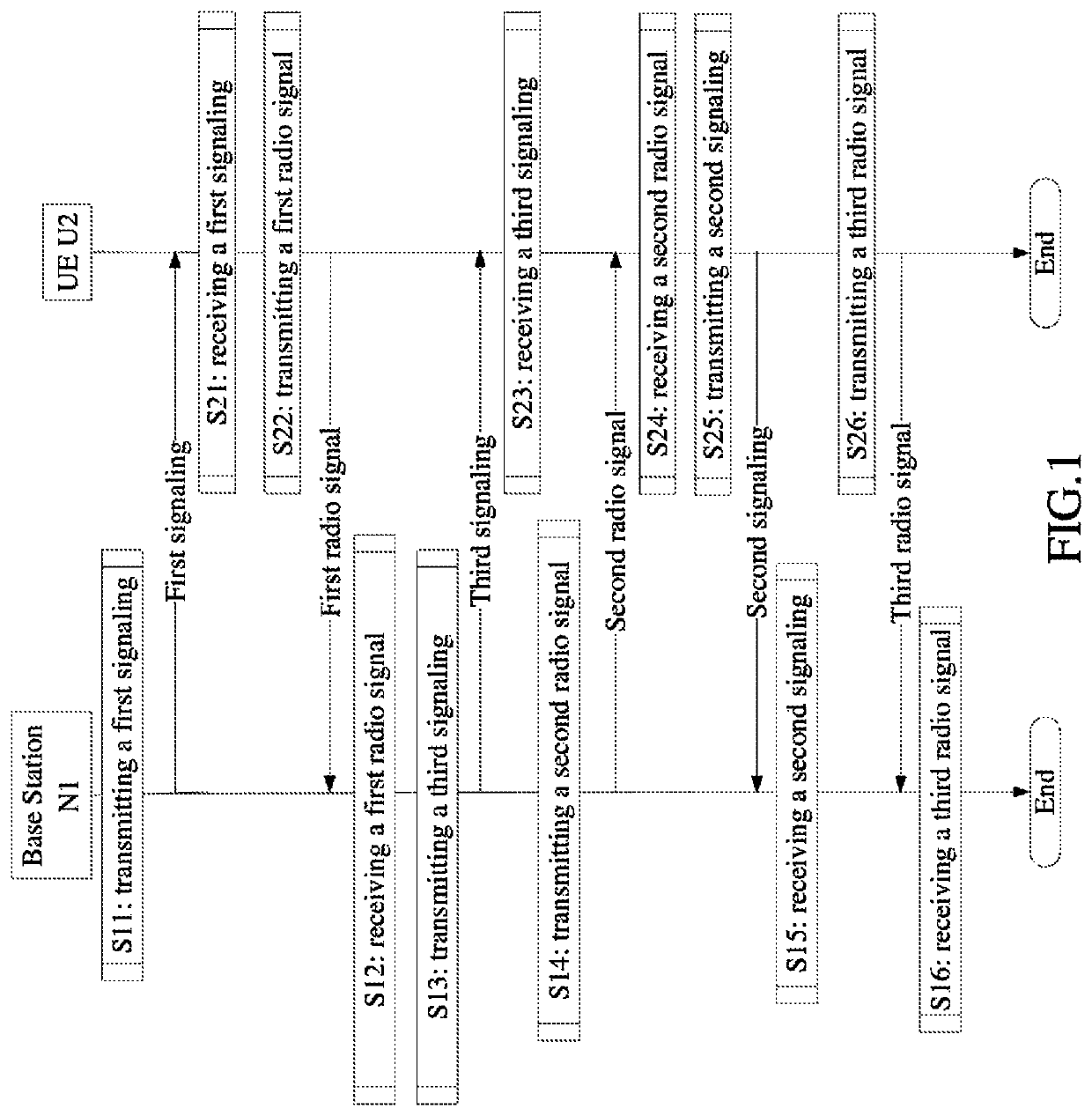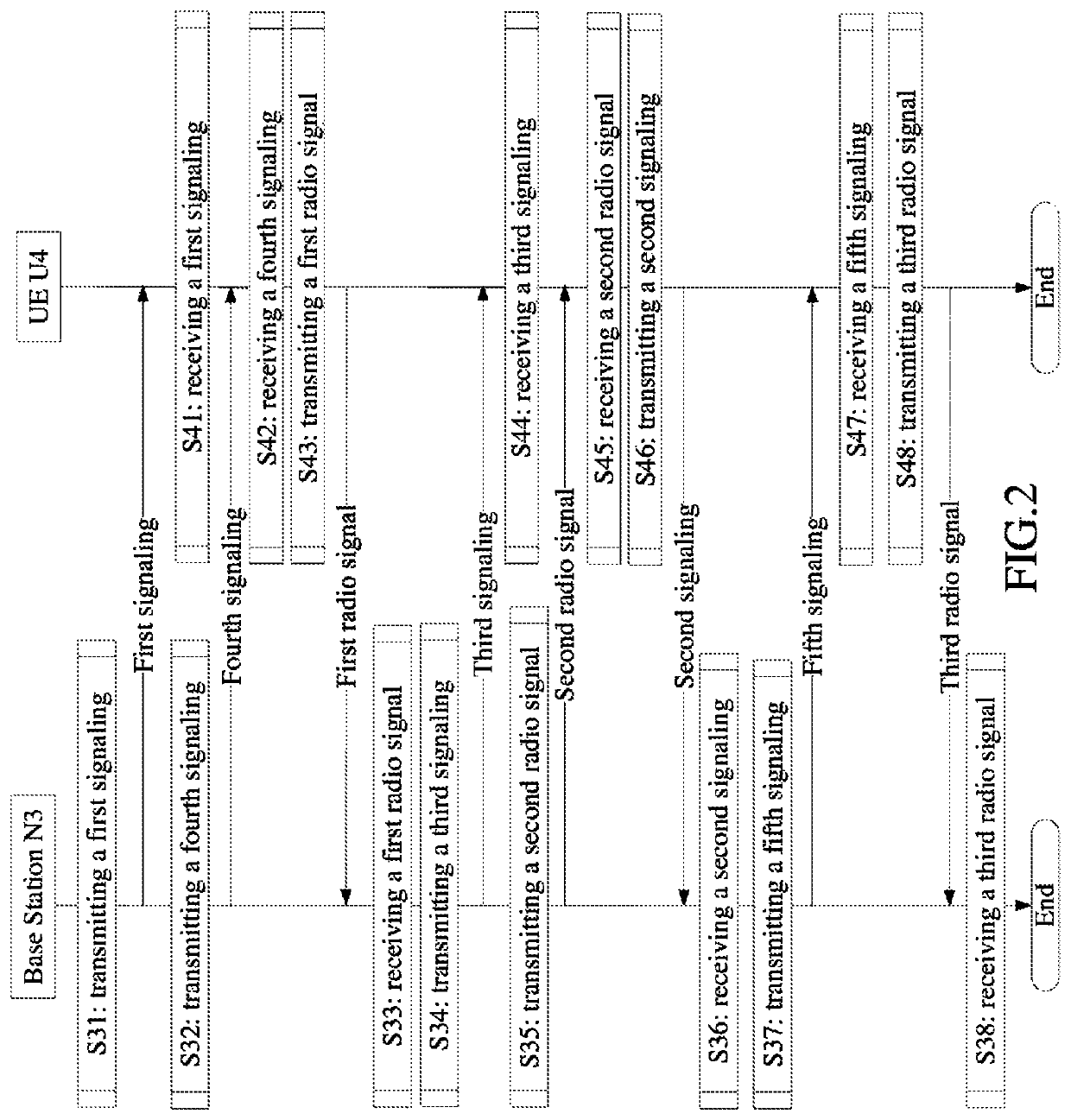Method and apparatus in user equipement and base station supporting enhanced random access procedure
a random access and user technology, applied in the direction of wireless communication, transmission path sub-channel allocation, high-level techniques, etc., can solve the problems of unresolved random access contention, power consumption, and inability to perform data uplink transmission before random access contention is solved
- Summary
- Abstract
- Description
- Claims
- Application Information
AI Technical Summary
Benefits of technology
Problems solved by technology
Method used
Image
Examples
embodiment 1
[0187]Embodiment 1 illustrates an example of a flowchart of transmission of a radio signal according to one embodiment of the disclosure, as shown in FIG. 1. In FIG. 1, a base station N1 is a maintenance base station for a serving cell of a UE U2.
[0188]The base station N1 transmits a first signaling in S11, receives a first radio signal in S12, transmits a third signaling in S13, transmits a second radio signal in S14, receives a second signaling in S15, and receives a third radio signal in S16.
[0189]The UE U2 receives a first signaling in S21, transmits a first radio signal in S22, receives a third signaling in S23, receives a second radio signal in S24, transmits a second signaling in S25, and transmits a third radio signal in S26.
[0190]In Embodiment 1, a first bit block is used for generating the first radio signal, the first bit block includes a positive integer number of bits, the first bit block carries a first identifier and a first data block, the first bit block lacks a fie...
embodiment 2
[0211]Embodiment 2 illustrates an example of a flowchart of transmission of a radio signal according to one embodiment of the disclosure, as shown in FIG. 2. In FIG. 2, a base station N3 is a maintenance base station for a serving cell of a UE U4.
[0212]The base station N3 transmits a first signaling in S31, transmits a fourth signaling in S32, receives a first radio signal in S33, transmits a third signaling in S34, transmits a second radio signal in S35, receives a second signaling in S36, transmits a fifth signaling in S37, and receives a third radio signal in S38.
[0213]The UE U4 receives a first signaling in S41, receives a fourth signaling in S42, transmits a first radio signal in S43, receives a third signaling in S44, receives a second radio signal in S45, transmits a second signaling in S46, receives a fifth signaling in S47, and transmits a third radio signal in S48.
[0214]In Embodiment 2, a first bit block is used for generating the first radio signal, the first bit block in...
embodiment 3
[0225]Embodiment 3 illustrates an example of a diagram of a first bit block according to one embodiment of the disclosure, as shown in FIG. 3. In FIG. 3, a rectangle filled with slashes represents bits occupied by a first identifier, a rectangle filled with horizontal lines represents bits occupied by a first data block, a rectangle filled with cross lines represents bits occupied by a first report, and a rectangle filled with grid lines represents a header included in a first bit block, and each bold-line blank box represents one baseband processing function that a first bit block experiences to generate a first radio signal.
[0226]In Embodiment 3, a first bit block is used for generating the first radio signal, the first bit block includes a positive integer number of bits, the first bit block carries a first identifier and a first data block, the first bit block lacks a field used for indicating RRC connection request cause information, a field used for indicating RRC connection r...
PUM
 Login to View More
Login to View More Abstract
Description
Claims
Application Information
 Login to View More
Login to View More - R&D
- Intellectual Property
- Life Sciences
- Materials
- Tech Scout
- Unparalleled Data Quality
- Higher Quality Content
- 60% Fewer Hallucinations
Browse by: Latest US Patents, China's latest patents, Technical Efficacy Thesaurus, Application Domain, Technology Topic, Popular Technical Reports.
© 2025 PatSnap. All rights reserved.Legal|Privacy policy|Modern Slavery Act Transparency Statement|Sitemap|About US| Contact US: help@patsnap.com



